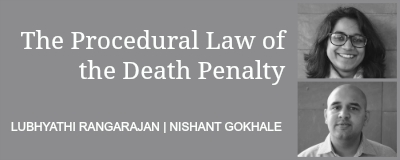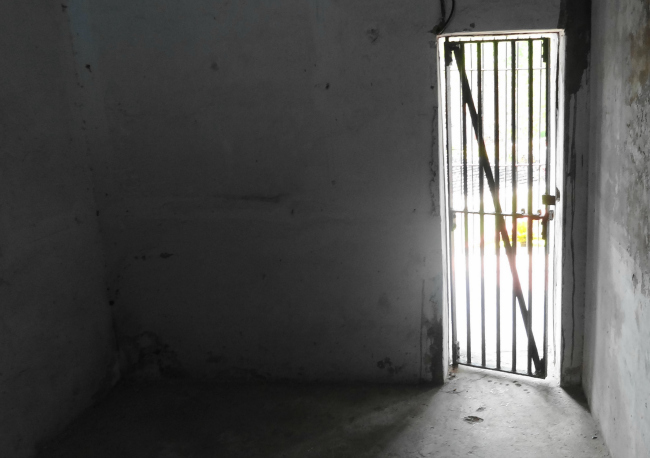Is a death sentence rendered by a sessions court final? Are there any checks on the powers of a sessions court over such an important decision? Can the High Court call new evidence in a death penalty proceeding? This note is an attempt for more clarity on these questions. The Code of Criminal Procedure, 1973 (“Code”) under Section 28(2), directs that a death sentence can be passed only by a sessions judge or an additional sessions judge. Further, the Code ensures that a sentence of death passed by a court of sessions (comprising either the Sessions or the Additional Sessions Judge) shall be subject to confirmation proceedings before the High Court exercising jurisdiction over it. Therefore, it is safe to conclude that the death sentence rendered by a sessions court is not final and is subject to the automatic supervision of the relevant High Court.
Sections 366 to 371 of the Code outline the confirmation proceedings before the High Court. In Bachan Singh (1980), the Apex Court noted that these provisions ensure that “the entire evidential material bearing on the innocence as[or] guilt of the accused and the question of sentence must be scrutinised with utmost caution and care by a superior court” considering that the outcome of the case would determine the life of an individual. It is interesting to note that similar confirmation provisions were also found in the old criminal procedure code of 1898 from Sections 374 to 380.
The confirmation process
Once the Sessions Court passes the death sentence, it is bound to refer the proceedings of the case to the High Court under Section 366(1) of the Code. Under Section 366(2) of the Code, a sentence of death cannot be executed unless it is confirmed by the High Court. As opposed to the 1898 Criminal Code, the 1973 Code includes a provision that authorises the Sessions Court to commit the convicted person to judicial custody (that is, jail). The Supreme Court has clarified in Sunil Batra (1979) that this custody cannot be considered equivalent to an imprisonment. The logic behind the provision is probably that the incentive to evade the legal process for a convicted person (sentenced to death by a sessions court) is very high and therefore the provisions seeks to address scenarios wherein the convict is not available for execution of the sentence.
It has been held in a catena of cases, including in State of Maharsahtra v. Sindhi and Jumman v. State of Punjab, that the confirmation proceedings are a continuation of the trial at the Sessions Court. Support for such an understanding can be derived from the fact that Section 366(1) states that the “proceedings” shall be submitted to the High Court unlike the appellate provisions where the factum of appeal lies in the conviction or acquittal or the enhancement of the sentence (Section 374 read with Section 386). There is however, a fundamental distinction between the confirmation proceedings at the High Court and a trial at the Sessions Court. While the Code, under Section 273, creates a general rule that all evidences taken in the course of the trial shall be taken in the presence of the accused, Section 367 states that the general rule in case of confirmation proceedings is that, unless the High Court feels otherwise, the presence of the convicted person is not required even when new evidence is taken. The Supreme Court has suggested that the presence or the absence of the accused does not make a difference at the confirmation stage since the High Court are duty bound to give the matters its utmost and undivided attention. Here, it is pertinent to mention that under the appellate jurisdiction, the Code in Section 391(3), grants the right to an accused (or his pleader) to be present when additional evidence is taken.
The Code also specifies that the confirmation proceedings should be conducted at least in front of a division bench of the High Court. Should there be any difference of opinion, the matter will be referred to a third judge whose decision will determine the final outcome of the case.
In death penalty cases, the normal practice is that the Sessions Court refers the matter for confirmation to the High Court and additionally, the convict files an appeal on his conviction under Section 374(2) of the Code. According to Section 368, the order of confirmation is not given until the appeal is disposed off by the high court. It is also clarified that there is no obligation on the convict that he must appeal his conviction to the High Court. Even if he does not, the constitutional court is duty bound to re-assess the death case.
Powers of the High Court
As discussed above, the power of a high court in confirmation proceedings is considered to be a continuation of trial. It is well settled that in a reference under the confirmation provision, the High Court has to consider the evidence afresh and arrive at its own independent findings with regard to the guilt of the accused, independent of the views of the Sessions Judge. At the same time, the Supreme Court has also cautioned that the conclusion arrived at by a sessions court cannot be completely overlooked.
Section 368 delineates the powers of a high court during a confirmation proceeding. The High Court can do the following: confirm the death sentence, pass any other sentence, annul the conviction but convict the accused of any other offence, order a new trial on the same or amended charge, and finally may also acquit the person. These powers look similar to the powers of the appellate court under Section 386. However, there are some essential differences between the confirmation and appellate proceedings.
Confirmation proceedings versus appellate proceedings
There are three major differences between the power of the High Court when it is seized of a confirmation proceeding and an appellate proceeding under the Code.
First, the reference to confirmation is automatic whereas appeal proceedings are only brought before the court if the distressed party files an appeal (and has a right to file one). A corollary of this situation is that in a criminal appeal, the court can dismiss the appeal if it decides that there is no ground for interference without examining the entire record. On the contrary, the High Court is duty bound to consider the entire evidence on record while confirming a death sentence.
Second, the confirmation court has a power to order further inquiry or take evidence (itself or by a lower court) without indicating any reason for doing so (under Section367(1)) whereas under Section 391(1), an appellate court has to provide written reasons to justify its act of taking new evidence (itself or by a lower court). Further, Section 391 does not empower the High Court sitting in the criminal appellate side to order further inquiry.
Finally, the appellate court has a certain leeway in not providing elaborate reasons should it agree with the findings of the trial court which is absent in confirmation cases. In confirmation proceedings, as written earlier, the High Court needs to come to an independent finding regarding the guilt of the accused and the sentence.
Special legislations and confirmation proceedings
Section 4(2) of the Code empowers the legislature to create separate trial proceedings for offences that are not part of the Indian Penal Code, 1860. There is therefore, a possibility that automatic confirmation proceedings available under the Code could be excluded. The (now repealed) Terrorist and Disruptive Activities (Prevention) Act, 1987 explicitly negated the role of the High Court and provided a direct right to appeal on both facts and law (not confirmation) to the Supreme Court under Section 19. Yakub Memon was hanged under this law and therefore, did not get the benefit of the confirmation proceedings at the High Court. Under the Prevention of Terrorism Act, 2002 (also repealed), the Parliament provided a right to appeal to the High Court both “on facts and on law” which was similar to the confirmation proceedings (but not the same). The same model was followed in the Unlawful Activities Prevention Act, 1967 through the National Investigation Agency Act, 2008 under Section 21. In POTA and UAPA, the cases are not automatically referred to the High Court, rather they must be appealed. The major difference lies in the fact that in the special laws, the appellate court only looks at the points raised by the appellant and does not examine the entire record, unlike a confirmation proceedings which operates independently of an appeal. At first glance, this situation is counter intuitive. One expects increased safeguards when special laws provide for prolonged period of police custody and the reversal of the burden of proof but the opposite situation prevails.
(Nishant Gokhale and Lubhyathi Rangarajan are Associates at the Death Penalty Litigation Clinic, National Law University, Delhi. Amrutanshu Dash is a student in his fifth year at the same law school. The Clinic was an intervenor in Yakub Memon’s case. The views expressed in this article are those of the authors alone.)



